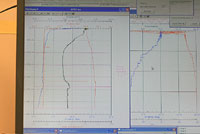

 | |||||||||||||||
|
|
Journals 2008/2009Jeff Lawrence
December 10, 2008 The ocean is full of currents that flow around the earth not only redistributing water but also bringing nutrients from one place in an ocean to another. Upwelling occurs when currents push generally colder and nutrient enriched water to the surface. This is valuable for the development of phytoplankton, microorganisms, and eventually all the other organisms all the way up the food chain including humans. Fisherman have known for a long time where these upwellings occur and that they provide excellent places for fishing since fish tend to migrate toward the ever enriching environments where phytoplankton develop. El Niño is a well-known phenomenon where this upwelling process is interrupted off the west coast of South America near Peru. Downwelling is the process where colder denser surface water such as that off the coast of Greenland is transported down deep into the Atlantic. This denser water then travels down the Atlantic southward and eventually spreads itself through most of the oceans before ending up in the Pacific Ocean. It takes thousands of years for this water to make its journey. Scientists are beginning to fear that the recent rise in global temperatures will cause the ice sheet to melt off of Greenland. If all that trapped cold fresh water enters the North Atlantic Conveyer system it could shut off some of the global ocean currents. This could have devastating effect first on microorganisms, then up the food chain.
While doing water sampling with a CTD on the Patagonian Shelf the North Atlantic Conveyor belt showed up on the CTD graph in the ships lab. If you look closely at the graph you will notice about two thirds of the way down between 2200 and 2500 meters all the parameters on the graph shift to the right a little. This reading was taken at 1500 GMT at 42°S, 56°W off the east coast of Argentina. This a slight increase in all the parameters indicating that is most likely the North Atlantic conveyor belt. The oceans' occupants rely heavily on these currents and the process of upwelling and downwelling for the pyramid of life to continue in them without interruption. Dr. Balch and his team are here to study the possible effects of increased CO2 levels on the microorganisms in the ocean. There are many factors that could affect their survival. Just as man has played a villainous role in the extinction of some of the oceans inhabitants, man may now play a role in many of the ocean inhabitant's very survival.
Questions of the day:
|
||||||||||||||


